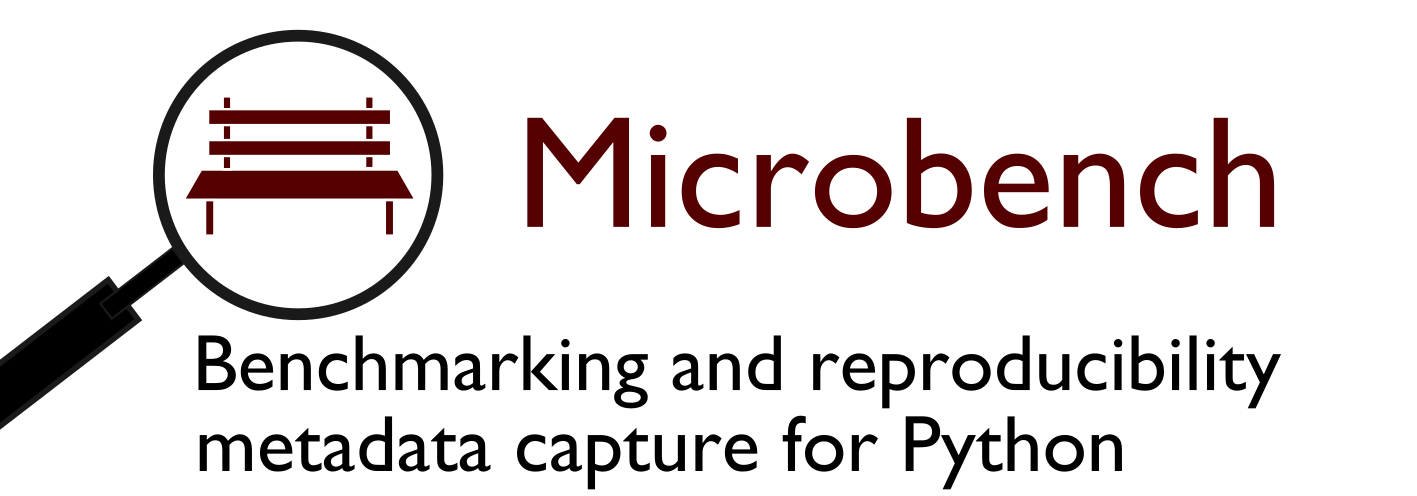微基准测试框架。可扩展,支持分布式/集群。
项目描述
Microbench
Microbench是一个用于基准测试Python函数的小型Python包,可选地捕获额外的运行时/环境信息。它在集群/分布式环境中非常有用,其中相同的函数在不同的环境中运行,并且设计为可扩展以添加新功能。除了基准测试外,这还可以通过记录关键Python包的版本或甚至全局环境中加载的所有包来帮助重现性。其他捕获的元数据可以包括CPU和RAM使用情况、环境变量和硬件规格。
要求
Microbench默认没有Python标准库之外的依赖,尽管建议使用pandas来检查结果。但是,某些混入(扩展)有特定的要求
- 需要安装line_profiler包来进行逐行代码基准测试。
MBInstalledPackages需要setuptools,这不是标准库的一部分,但通常可用。- 核心CPU、总RAM和遥测扩展需要psutil。
- NVIDIA GPU插件需要nvidia-smi实用工具,该工具通常随NVIDIA显卡驱动程序一起提供。它需要在您的
PATH中。
安装
要使用pip安装
pip install microbench
用法
Microbench是为基准测试Python函数而设计的。以下示例将假设您已经定义了一个名为myfunction的Python函数,您希望对其进行基准测试
def myfunction(arg1, arg2, ...):
...
最小示例
首先,创建一个基准测试套件,指定配置和要捕获的信息。
以下是一个最小、完整的示例
from microbench import MicroBench
basic_bench = MicroBench()
要将基准测试附加到您的函数上,只需使用装饰器basic_bench,如下所示:
@basic_bench
def myfunction(arg1, arg2, ...):
...
就这么多!当调用myfunction()时,元数据将被捕获到io.StringIO()缓冲区中,可以按照以下方式读取(使用pandas库):
import pandas as pd
results = pd.read_json(basic_bench.outfile, lines=True)
上述示例捕获了字段start_time(开始时间)、finish_time(结束时间)、run_durations(每个函数调用,默认为秒),function_name(函数名称)、timestamp_tz(时区名称,参见此README中的时区部分),以及duration_counter(用于计算持续时间的函数名称,参见此README中的持续时间计时部分)。
微基准测试可以捕获来自环境、资源使用和硬件的许多其他类型的元数据,以下将介绍。
扩展示例
以下是一个使用混入(以MB前缀的类名)扩展功能更完整的示例。请注意,可以向构造函数(在此情况下some_info=123)提供关键字参数来指定要捕获的附加信息。我们还将指定iterations=3,这意味着将被调用的函数将执行3次(返回的结果始终是最后一次运行的结果)并且会捕获每次运行的计时。我们指定了自定义持续时间计数器,time.monotonic而不是默认的time.perf_counter(有关说明,请参见此README后面的持续时间计时部分)。此示例还指定了outfile选项,该选项将元数据追加到磁盘上的文件。
from microbench import *
import numpy, pandas, time
class MyBench(MicroBench, MBFunctionCall, MBPythonVersion, MBHostInfo):
outfile = '/home/user/my-benchmarks'
capture_versions = (numpy, pandas) # Or use MBGlobalPackages/MBInstalledPackages
env_vars = ('SLURM_ARRAY_TASK_ID', )
benchmark = MyBench(some_info=123, iterations=3, duration_counter=time.monotonic)
上述示例中的env_vars选项指定了一个要捕获为env_<变量名称>的环境变量列表。在此示例中,slurm数组任务ID将被存储为env_SLURM_ARRAY_TASK_ID。如果未设置环境变量,则值将为null。
要捕获软件包版本,您可以直接指定它们(如上所示),或者捕获全局环境中每个软件包的版本。在以下示例中,我们将自动捕获microbench、numpy和pandas的版本。
from microbench import *
import numpy, pandas
class Bench2(MicroBench, MBGlobalPackages):
outfile = '/home/user/bench2'
bench2 = Bench2()
如果您想更进一步,并捕获每个可导入软件包的版本,有一个混入可以实现这一点
from microbench import *
class Bench3(MicroBench, MBInstalledPackages):
pass
bench3 = Bench3()
| 混入 | 捕获的字段 |
|---|---|
| (默认) | start_timefinish_timefunction_name |
| MBGlobalPackages | package_versions,包含全局环境中每个软件包的条目 |
| MBInstalledPackages | package_versions,包含每个可导入软件包的条目 |
| MBCondaPackages | conda_versions,包含环境中每个conda软件包的条目 |
| MBFunctionCall | args(位置参数)kwargs(关键字参数) |
| MBReturnValue | 包装函数的返回值 |
| MBPythonVersion | python_version(例如,3.6.0)和python_executable(例如,/usr/bin/python,这应该表明任何活动的虚拟环境) |
| MBHostInfo | hostnameoperating_system |
| MBHostCpuCores | cpu_cores_logical(核心数,需要psutil) |
| MBHostRamTotal | ram_total(总RAM字节数,需要psutil) |
| MBNvidiaSmi | 各种NVIDIA GPU字段,将在后面的部分中详细介绍 |
| MBLineProfiler | line_profiler包含逐行分析(请参见下面的部分) |
检查结果
每个结果都是一个JSON对象。当使用outfile选项时,每个@benchmark调用的JSON对象都会存储在文件的单独一行。上述最小示例的输出(针对单次运行)将类似于以下内容
{"start_time": "2018-08-06T10:28:24.806493+00:00", "finish_time": "2018-08-06T10:28:24.867456+00:00", "run_durations": [0.60857599999999999], "function_name": "my_function", "timestamp_tz": "UTC", "duration_counter": "perf_counter"}
开始和结束时间以ISO-8601格式的时间戳给出,默认为UTC时区(请参见此README中的时区部分)。
运行持续时间以秒给出,默认使用time.perf_counter函数捕获,但可以覆盖(请参见此README后面的持续时间计时部分)。
最简单的方法是详细检查结果,就是将它们加载到pandas数据框中。
# Read results directly from active benchmark suite
benchmark.get_results()
# Or, equivalently when using a file, read it using pandas directly
import pandas
results = pandas.read_json('/home/user/my-benchmarks', lines=True)
Pandas具有强大的数据处理能力。例如,可以通过Python版本计算平均运行时间。
# Calculate overall runtime
results['runtime'] = results['finish_time'] - results['start_time']
# Average overall runtime by Python version
results.groupby('python_version')['runtime'].mean()
还有更多高级操作可用。建议阅读pandas教程。
行分析器支持
Microbench还支持line_profiler,该工具显示Python代码每一行的执行时间。注意,这将减慢你的代码速度,所以仅在需要时使用它,但它在发现函数中的瓶颈时很有用。需要安装line_profiler包(例如:pip install line_profiler)。
from microbench import MicroBench, MBLineProfiler
import pandas
# Create our benchmark suite using the MBLineProfiler mixin
class LineProfilerBench(MicroBench, MBLineProfiler):
pass
lpbench = LineProfilerBench()
# Decorate our function with the benchmark suite
@lpbench
def my_function():
""" Inefficient function for line profiler """
acc = 0
for i in range(1000000):
acc += i
return acc
# Call the function as normal
my_function()
# Read the results into a Pandas DataFrame
results = lpbench.get_results()
# Get the line profiler report as an object
lp = MBLineProfiler.decode_line_profile(results['line_profiler'][0])
# Print the line profiler report
MBLineProfiler.print_line_profile(results['line_profiler'][0])
上一个示例的最后一条语句将打印行分析器报告,显示每一行代码的执行时间。示例
Timer unit: 1e-06 s
Total time: 0.476723 s
File: /home/user/my_test.py
Function: my_function at line 12
Line # Hits Time Per Hit % Time Line Contents
==============================================================
12 @lpbench
13 def my_function():
14 """ Inefficient function for line profiler """
15 1 2.0 2.0 0.0 acc = 0
16 1000001 217874.0 0.2 45.7 for i in range(1000000):
17 1000000 258846.0 0.3 54.3 acc += i
18
19 1 1.0 1.0 0.0 return acc
NVIDIA GPU支持
可以使用MBNvidiaSmi插件捕获有关NVIDIA GPU的属性。这需要当前PATH中可用nvidia-smi实用程序。
默认情况下,会捕获gpu_name(型号号)和memory.total属性。可以使用类或对象级别的变量nvidia_attributes指定额外属性。要查看可用的属性,请运行nvidia-smi --help-query-gpu。
默认情况下,将轮询所有安装的GPU。要限制特定GPU,请指定nvidia_gpus属性为GPU ID的元组,可以是基于零的GPU索引(重启之间可能更改,不推荐),GPU UUID或PCI总线ID。您可以通过运行nvidia-smi -L来找到GPU UUID。
下面是一个指定可选的nvidia_attributes和nvidia_gpus字段的示例
from microbench import MicroBench, MBNvidiaSmi
class GpuBench(MicroBench, MBNvidiaSmi):
outfile = '/home/user/gpu-benchmarks'
nvidia_attributes = ('gpu_name', 'memory.total', 'pcie.link.width.max')
nvidia_gpus = (0, ) # Usually better to specify GPU UUIDs here instead
gpu_bench = GpuBench()
遥测支持
我们使用“遥测”一词来指函数由并行运行的线程定期执行期间捕获的元数据。例如,这可以用来查看内存使用随时间的变化。
遥测支持需要psutil库。
Microbench会自动启动和清理监控线程。最终用户只需要定义一个telemetry静态方法,该方法接受一个psutil.Process对象,并返回作为字典的遥测数据。
默认遥测收集间隔是每60秒,如果需要,可以使用telemetry_interval类变量进行自定义。
下面是一个捕获每90秒内存使用的最小示例
from microbench import MicroBench
class TelemBench(MicroBench):
telemetry_interval = 90
@staticmethod
def telemetry(process):
return process.memory_full_info()._asdict()
telem_bench = TelemBench()
扩展microbench
Microbench包含一些混合功能,如上述扩展示例中所述。
您还可以向基准测试套件添加函数,在运行时捕获额外信息。这些函数必须以capture_前缀开头,以便在函数开始之前自动运行,或者以capturepost_前缀开头,以便在函数完成时自动运行。它们接受单个参数,bm_data,这是一个要扩展额外数据的字典。应小心避免覆盖现有的键名。
以下是一个捕获机器类型(例如:i386,x86_64等)的示例
from microbench import MicroBench
import platform
class Bench(MicroBench):
outfile = '/home/user/my-benchmarks'
def capture_machine_platform(self, bm_data):
bm_data['platform'] = platform.machine()
benchmark = Bench()
扩展JSONEncoder
Microbench将数据编码为JSON,但有时Microbench会遇到默认情况下无法编码为JSON的数据类型(例如自定义对象或类)。例如,在使用MBFunctionCall和MBReturnValue时,如果任何参数或返回值(分别)无法编码为JSON,将显示警告,并将值替换为占位符以允许元数据捕获继续,并显示警告。
如果您希望实际捕获这些值,您需要指定一种将对象转换为JSON的方法。这可以通过扩展microbench.JSONEncoder并实现对象类型的测试以及字符串、列表或字典的转换来完成。
例如,要使用str(graph)作为表示来捕获来自igraph包的Graph对象,我们可以执行以下操作(注意,我们可以使用我们想要的任何表示,例如,如果我们想以更详细或更简略的方式捕获对象)
import microbench as mb
from igraph import Graph
# Extend the JSONEncoder to encode Graph objects
class CustomJSONEncoder(mb.JSONEncoder):
def default(self, o):
# Encode igraph.Graph objects as strings
if isinstance(o, Graph):
return str(o)
# Add further isinstance(o, ...) cases here
# if needed
# Make sure to call super() to handle
# default cases
return super().default(o)
# Define your benchmark class as normal
class Bench(mb.MicroBench, mb.MBReturnValue):
pass
# Create a benchmark suite with the custom JSON
# encoder from above
bench = Bench(json_encoder=CustomJSONEncoder)
# Attach the benchmark suite to our function
@bench
def return_a_graph():
return Graph(2, ((0, 1), (0, 2)))
# This should now work without warnings or errors
return_a_graph()
Redis支持
默认情况下,microbench将输出追加到文件中,但输出可以指向其他地方,例如redis -一个内存中的、网络化的数据源。当共享文件系统不可用的情况下,此选项非常有用。
Redis支持需要redis-py。
要使用此功能,请从MicroBench继承而不是从MicroBenchRedis继承,并指定redis连接和键名,如下面的示例所示
from microbench import MicroBenchRedis
class RedisBench(MicroBenchRedis):
# redis_connection contains arguments for redis.StrictClient()
redis_connection = {'host': 'localhost', 'port': 6379}
redis_key = 'microbench:mykey'
benchmark = RedisBench()
要检索结果,可以直接使用redis包
import redis
import pandas
# Establish the connection to redis
rconn = redis.StrictRedis(host=..., port=...)
# Read the redis data from 'myrediskey' into a list of byte arrays
redis_data = redis.lrange('myrediskey', 0, -1)
# Convert the list into a single string
json_data = '\n'.join(r.decode('utf8') for r in redis_data)
# Read the string into a pandas dataframe
results = pandas.read_json(json_data, lines=True)
运行时影响考虑因素
运行时影响取决于捕获的信息和平台。一般来说,捕获环境变量、Python包版本和函数的计时信息的影响可以忽略不计。捕获遥测和调用外部程序(如用于GPU信息的nvidia-smi)影响较大,尽管后者是每次调用的一个操作,并且通常不到一秒。遥测捕获间隔应相对频繁(例如,每分钟或两分钟,而不是每秒)以避免显著的影响。
持续时间计时
默认情况下,run_durations使用time.perf_counter函数以秒为单位给出,这对于大多数用例应该足够。您可以使用返回浮点数或整数的任何函数来获取时间。一些示例包括,如果您想以纳秒为单位获取时间,可以使用time.perf_counter_ns,或者如果您需要一个不受时钟调整影响的单调时钟(对于非常长时间运行的代码),可以使用time.monotonic。在创建基准测试套件对象时使用duration_counter=...参数,如本README的扩展示例部分所示。
时区
Microbench默认以UTC时区捕获start_time和finish_time。这可以通过在创建基准类时传递tz=...参数来覆盖,其中值是一个时区对象(例如,使用pytz库创建)。
反馈
请注意,这是一个新创建的、实验性的包。请通过GitHub问题告诉我您的反馈或功能请求。
项目详情
microbench-0.9.1.tar.gz的哈希
| 算法 | 哈希摘要 | |
|---|---|---|
| SHA256 | 0548a68a37f554bed83e8f6092fffa116c2ec7fe64ed44150e41903c28beb658 |
|
| MD5 | a985b7ed8cbe074e317aae2b162d2a51 |
|
| BLAKE2b-256 | 954514b404d377c5af66a20069427dcf9a306c3783de8afb9a7655604b929eb9 |




